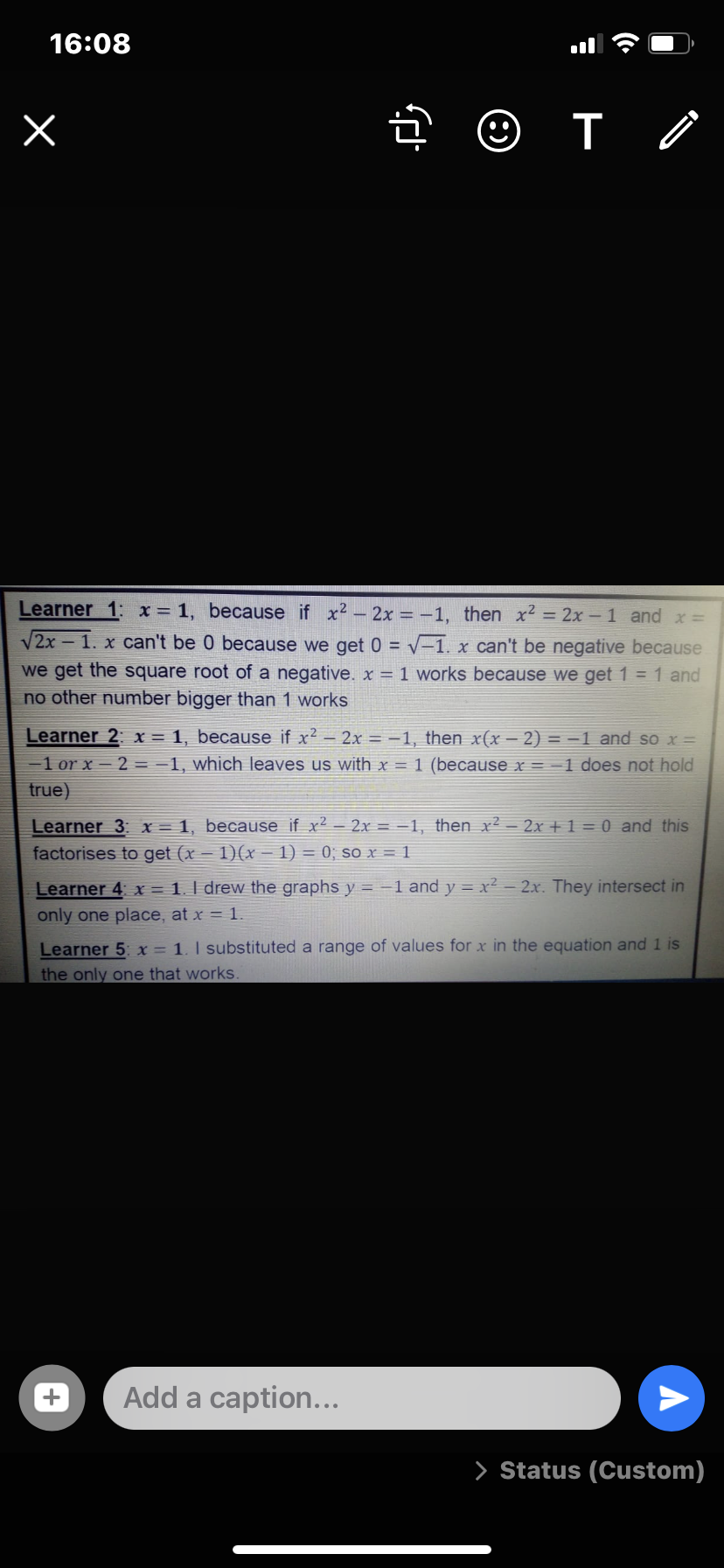Learner 1: x = 1, because if x2- 2x = -1, then x² = 2x – 1 and x = V2x - 1. x can't be 0 because we get 0 = v-1. x can't be negative because we get the square root of a negative. x = 1 works because we get 1 = 1 and no other number bigger than 1 works %3D Learner 2: x = 1, because if x² – 2x =-1, then x(x – 2) = –1 and so x = -1 or x – 2 = -1, which leaves us with x = 1 (because x = -1 does not hold %3D !! true) Learner 3: x = 1, because if x² – 2x = -1, then x² – 2x+1 = 0 and this factorises to get (x – 1)(x – 1) = 0; so x = 1 Learner 4: x = 1. I drew the graphs y = 1 and y = x² – 2x. They intersect in only one place, at x = 1. - Learner 5: x = 1. | substituted a range of values for x in the equation and 1 is the only one that works.
Learner 1: x = 1, because if x2- 2x = -1, then x² = 2x – 1 and x = V2x - 1. x can't be 0 because we get 0 = v-1. x can't be negative because we get the square root of a negative. x = 1 works because we get 1 = 1 and no other number bigger than 1 works %3D Learner 2: x = 1, because if x² – 2x =-1, then x(x – 2) = –1 and so x = -1 or x – 2 = -1, which leaves us with x = 1 (because x = -1 does not hold %3D !! true) Learner 3: x = 1, because if x² – 2x = -1, then x² – 2x+1 = 0 and this factorises to get (x – 1)(x – 1) = 0; so x = 1 Learner 4: x = 1. I drew the graphs y = 1 and y = x² – 2x. They intersect in only one place, at x = 1. - Learner 5: x = 1. | substituted a range of values for x in the equation and 1 is the only one that works.
Algebra & Trigonometry with Analytic Geometry
13th Edition
ISBN:9781133382119
Author:Swokowski
Publisher:Swokowski
Chapter10: Sequences, Series, And Probability
Section: Chapter Questions
Problem 63RE
Related questions
Question
100%
The learners solved this x2 = 2x - 1 , show which learner is correct and which is wrong, and also provide reasons

Transcribed Image Text:16:08
Learner 1: x = 1, because if x2 - 2x = -1, then x² = 2x – 1 and x =
V2x - 1. x can't be 0 because we get 0 = V-1. x can't be negative because
we get the square root of a negative. x = 1 works because we get 1 = 1 and
no other number bigger than 1 works
Learner 2: x = 1, because if x² – 2x = -1, then x(x – 2) = -1 and so x =
-1 or x – 2 ==1, which leaves us with x = 1 (because x = -1 does not hold
true)
Learner 3: x = 1, because if x² – 2x = -1, then x² – 2x + 1 = 0 and this
factorises to get (x – 1)(x – 1) = 0; so x = 1
Learner 4: x = 1. I drew the graphs y = 1 and y = x² 2x. They intersect in
only one place, at x = 1.
Learner 5: x = 1. | substituted a range of values for x in the equation and 1 is
the only one that works.
Add a caption...
> Status (Custom)
+
Expert Solution
This question has been solved!
Explore an expertly crafted, step-by-step solution for a thorough understanding of key concepts.
This is a popular solution!
Trending now
This is a popular solution!
Step by step
Solved in 2 steps with 2 images

Recommended textbooks for you

Algebra & Trigonometry with Analytic Geometry
Algebra
ISBN:
9781133382119
Author:
Swokowski
Publisher:
Cengage

Linear Algebra: A Modern Introduction
Algebra
ISBN:
9781285463247
Author:
David Poole
Publisher:
Cengage Learning

Algebra & Trigonometry with Analytic Geometry
Algebra
ISBN:
9781133382119
Author:
Swokowski
Publisher:
Cengage

Linear Algebra: A Modern Introduction
Algebra
ISBN:
9781285463247
Author:
David Poole
Publisher:
Cengage Learning